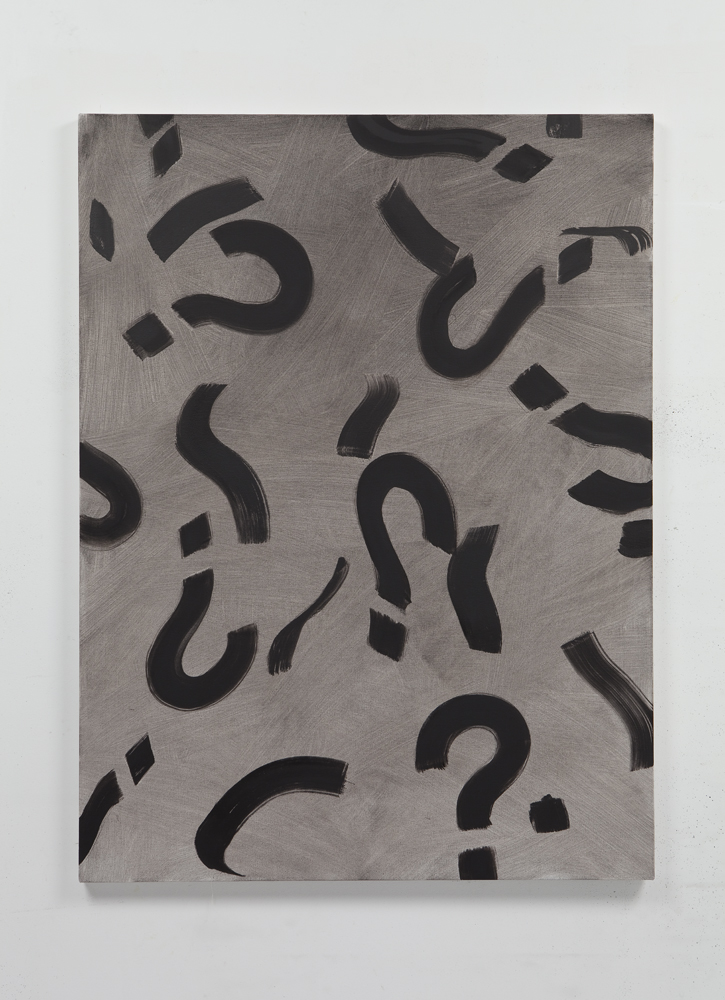Gregory Edwards
I want a painting to be multifaceted, like a personality. It has to have more than one layer, even though it can still be very simple. Gregory Edward
In a series of oil paintings by Gregory Edwards from 2012, question marks squirm like amoebas across the canvas or line up in a militaristic grid over a florescent checkerboard or over a horizon backdrop of blue and sandy brown. The question mark might serve as an entry point to the 32-year-old artist’s ongoing interest in the push and pull between abstraction and representation, the open-ended sense of play in his wild, often ostentatious patterning and his rigid structural control, and flat, thinly applied surfaces. After all, a question mark added to any last word turns the work of interpretation onto the audience. “All of these attitudes or elements float around in my paintings,” Edwards says. “Nothing’s settled. I like the idea of something being pleasing and unsettling.”
Often, for the Long Island native Edwards, who attended the School of Visual Arts and the Städelschule, Staatliche Hochschule für Bildende Künst in Frankfurt, the initial inspiration for a motif hails directly from observations from the world. The source for a suite of paintings that incorporated polka dots over leopard print was a video of the New York Dolls’ David Johansen, who paired a polka-dot shirt with a leopard scarf. “I’d never seen those two designs on top of each other, even though they’re so ubiquitous,” he explains. “You can find leopard print in the most expensive luxury items and also in discount stores on Canal Street.”
This gleeful confusion between the natural and the faux-natural re-inscribed into a formal painterly schema seems to simultaneously vacate any expressive gesture and also revive the pattern with hostile, meaningful possibilities. As another example, take a group of paintings that mimic the horizontal metal blinds from Edwards’s own New York bedroom. Projecting an image of the blind grid onto a canvas in his East Williamsburg studio in the dark, he allowed himself to fill in the contours of the lines with an almost haphazard mash of colorful paint strokes, thereby enlivening a device traditionally used to shut the world out.
Edwards’ organizational principles seem to wage war with his preferred palate of “tertiary colors”—rancid yellows, plastic grays, poisonous orange—for a “queasy beauty” of irresolution. Perfect states devolve into imperfect visual echo chambers. “I could give you a cynical angle on any of my paintings easily,” he says. “But at the same time, I want a painting to be multifaceted, like a personality. It has to have more than one layer, even though it can still be very simple. A person can smile and the smile can mean five different things. Purity isn’t really the human experience.” For a solo show in February at New York’s 47 Canal, Edwards is experimenting with the addition of loaded catchwords inspired by the culture of positive thinking and self-help books like The Secret or The 7 Habits of Highly Effective People into abstract color bands on his canvases. Attraction and Information float amid monochromatic stripes or looping brushstrokes and drips. The color bands originated from a flawed gradient when printing out template sketches in Photoshop. “The words keep the work from becoming pure abstraction,” he says. “Even though they come from these pseudoscience sources, you have to deal with the words on some level.”
To return to The New Abstract, click here.







